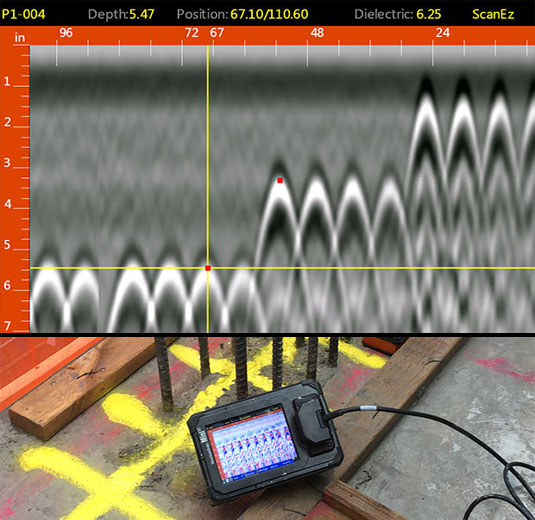Introduce the Transformative Power of Concrete Scanning in Optimizing Performance and Safety And Security
Concrete scanning has emerged as an important tool in the construction market, using unmatched advantages in boosting project effectiveness and ensuring safety and security criteria. The transformative power of concrete scanning exists in its ability to offer thorough insights and real-time information, changing how projects are intended and performed.
Value of Concrete Scanning
Guaranteeing the structural stability and security of building projects starts with the vital action of conducting complete concrete scanning. Concrete scanning is a non-destructive technique used to identify and map subsurface elements within concrete frameworks.
Furthermore, concrete scanning helps in enhancing task timelines and budget plan by preventing unanticipated prices and delays that may emerge due to unexpected obstructions within the concrete. Ultimately, investing in thorough concrete scanning is an aggressive method that boosts both performance and security in building and construction tasks.
Exactly How Concrete Scanning Functions
Concrete scanning runs as a vital tool in building and construction tasks by utilizing sophisticated technologies to detect and map subsurface elements without creating structural damages. Ground Penetrating Radar (GPR) and Electromagnetic Induction (EMI) are 2 key techniques made use of in concrete scanning.
During the scanning process, the data gathered is examined in real-time, permitting instant identification of potential hazards or obstacles below the surface. This details help in decision-making, ensuring that construction tasks continue securely and successfully. Additionally, 3D imaging software can be made use of to create topographic maps of the subsurface aspects, further enhancing job planning and execution. By utilizing these advanced technologies, concrete scanning substantially minimizes the risk of expensive damages and injuries on building sites.
Advantages of Concrete Scanning
Using sophisticated scanning innovations in building projects offers a plethora of advantages, enhancing both effectiveness and safety on-site. Among the main advantages of concrete scanning is the ability to identify and situate ingrained things such as rebar, post-tension wires, and channels accurately. By recognizing these components prior to drilling or reducing right into concrete structures, the risk of unintended strikes is substantially reduced, preventing possible injuries to workers and damages to the framework itself. Moreover, concrete scanning aids in planning and developing better, as it supplies specific info concerning the place and depth of structural components.

Study: Concrete Scanning Success

In another instance, a building and construction firm made use of 3D concrete scanning to analyze the problem of maturing concrete structures in a historical structure. The comprehensive scans provided valuable insights right into the degree of degeneration and helped focus on upkeep efforts properly. By proactively resolving locations of issue determined with scanning, the business had the ability to expand the life-span of the structure and make certain resident safety.
These study underscore the transformative power of concrete scanning in enhancing performance, content accuracy, and safety and security in construction projects.
Implementing Concrete Scanning in Projects
Executing sophisticated scanning modern technologies throughout building and construction tasks has ended up being increasingly crucial for improving accuracy and safety. By integrating concrete scanning into project preparation and execution, building teams can determine prospective dangers, such as rebar or post-tension wires, concealed within concrete structures. This positive approach minimizes the danger of crashes, delays, and pricey rework, ultimately leading to much more effective task timelines and spending plans.
To execute concrete scanning efficiently, job managers need to team up carefully with seasoned scanning experts to determine one of the most suitable scanning strategies for the specific task demands. Involving scanning professionals from the onset of a task makes it possible for the group to produce extensive scanning strategies that attend to vital areas of worry and make certain extensive information collection.
Additionally, incorporating concrete scanning right into normal project workflows can simplify decision-making processes, as real-time check information offers prompt understandings into the problem of concrete frameworks - Concrete Scanning. This data-driven method facilitates notified problem-solving and enables groups to make adjustments promptly, fostering a society of effectiveness and safety and security throughout the job lifecycle

Final Thought
Finally, concrete scanning plays a critical function in boosting effectiveness and safety and security in building jobs. By making use of sophisticated innovation to map and detect out underlying structures within concrete, this procedure helps to stop costly blunders, make sure architectural stability, and minimize risks on site. With the ability to uncover concealed Read Full Report aspects and supply accurate information, concrete scanning confirms to be a useful tool for maximizing job outcomes and maximizing total success.
Concrete scanning is a non-destructive approach used to identify and map subsurface aspects within concrete structures. Furthermore, concrete scanning assists in optimizing task timelines and spending plan by staying clear of unexpected click to investigate expenses and delays that might occur due to unpredicted blockages within the concrete. One remarkable situation research entails a large improvement project where concrete scanning played an important duty in guaranteeing project success.In one more instance, a building firm utilized 3D concrete scanning to evaluate the problem of maturing concrete structures in a historical building. By incorporating concrete scanning right into task preparation and implementation, building groups can determine prospective threats, such as rebar or post-tension cable televisions, hidden within concrete structures.